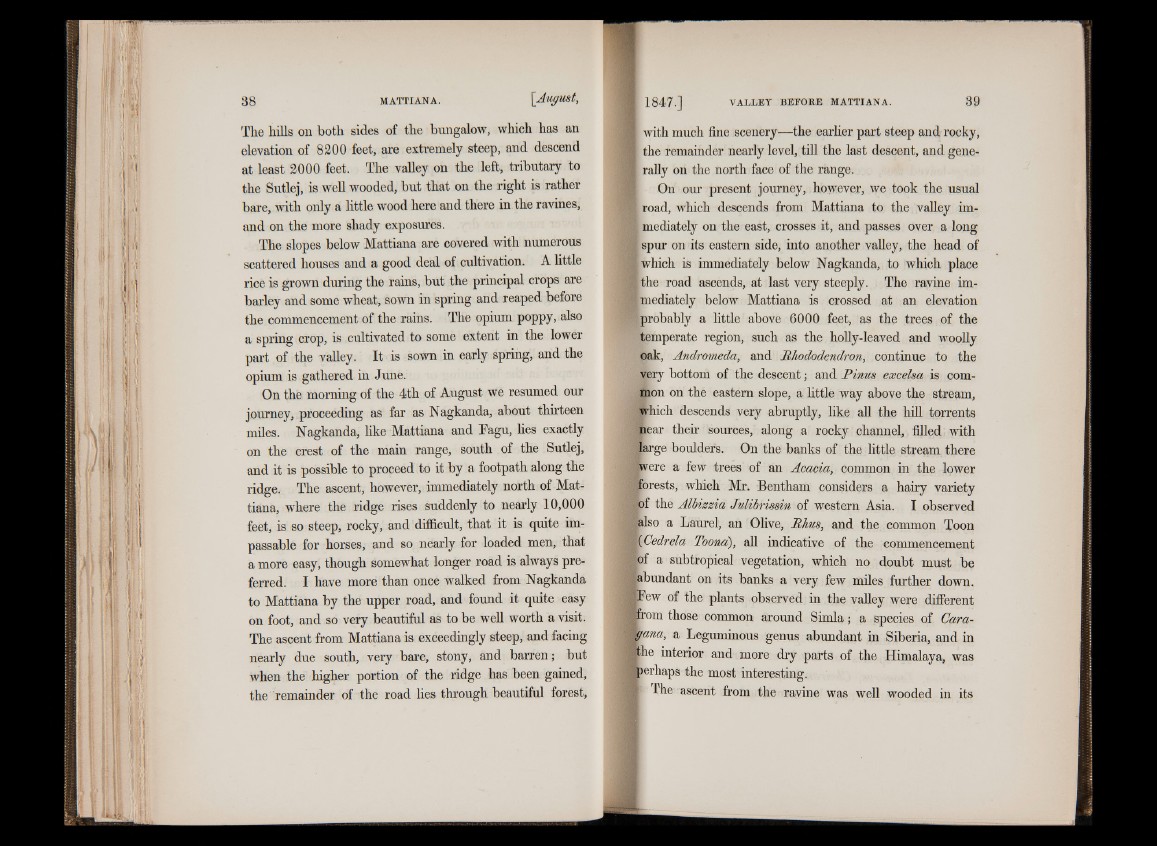
38 MATTIANA. [August,
The hills on both sides of the bungalow, which has an
elevation of 8200 feet, are extremely steep, and descend
at least 2000 feet. The valley on the left, tributary to
the Sutlej, is well wooded, but that on the right is rather
bare, with only a little wood here and there in the ravines,
and on the more shady exposures.
The slopes below Mattiana are covered with numerous
scattered houses and a good deal of cultivation. A little
rice is grown during the rains, but the principal crops are
barley and some wheat, sown in spring and reaped before
the commencement of the rains. The opium poppy, also
a spring crop, is cultivated to some extent in the lower
part of the valley. It is sown in early spring, and the
opium is gathered in June.
On the morning of the 4th of August we resumed our
journey, proceeding as far as Nagkanda, about thirteen
miles. Nagkanda, like Mattiana and Tagu, lies exactly
on the crest of the main range, south of the Sutlej,
and it is possible to proceed to it by a footpath along the
ridge. The ascent, however, immediately north of Mattiana,
where the ridge rises suddenly to nearly 10,000
feet, is so steep, rocky, and difficult, that it is quite impassable
for horses, and so nearly for loaded men, that
a more easy, though somewhat longer road is always preferred.
I have more than once walked from Nagkanda
to Mattiana by the upper road, and found it quite easy
on foot, and so very beautiful as to be well worth a visit.
The ascent from Mattiana is exceedingly steep, and facing
nearly due south, very bare, stony, and barren; but
when the higher portion of the ridge has been gained,
the remainder of the road lies through beautiful forest,
I 1847.J VALLEY BEFORE MATTIANA. 39
I with much fine scenery—the earlier part steep and rocky,
I the remainder nearly level, till the last descent, and gene-
I rally on the north face of the range.
On our present journey, however, we took the usual
■ road, which descends from Mattiana to the valley im-
■ mediately on the east, crosses it, and passes over a long
■ spur on its eastern side, into another valley, the head of
■ which is immediately below Nagkanda, to which place
I the road ascends, at last very steeply. The ravine im-
■mediately below Mattiana is crossed at an elevation
^probably a little above 6000 feet, as the trees of the
temperate region, such as the holly-leaved and woolly
oak, Andromeda, and Rhododendron, continue to the
yery bottom of the descent; and Pinus excelsa is common
on the eastern slope, a little way above the stream,
which descends very abruptly, like all the hill torrents
near their sources, along a rocky channel, filled with
farge boulders. On the banks of the little stream there
were a few trees of an Acacia, common in the lower
■orests, which Mr. Bentham considers a hairy variety
of the Albizzia Julibrissin of western Asia. I observed
».Iso a Laurel, an Olive, Rhus, and the common Toon
m(Cedrela Toona), all indicative of the commencement
of a subtropical vegetation, which no doubt must be
«abundant on its banks a very few miles further down,
■pew of the plants observed in the valley were different
■from those common around Simla; a species of Cara-
gana, a Leguminous genus abundant in Siberia, and in
■the interior and more dry parts of the Himalaya, was
^perhaps the most interesting.
The ascent from the ravine was well wooded in its